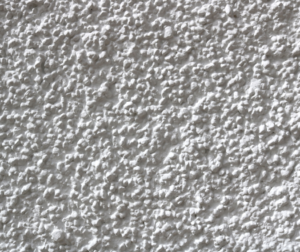
Popcorn ceilings, once popular for their ability to hide imperfections and absorb sound, have become outdated in modern homes, to say the least. Many homeowners these days are opting to remove these textured ceilings in favor of more sleek, modern design schemes. If you’re considering taking on this project yourself, it’s entirely possible with the right tools and preparation; however, the process can be messy and time-consuming, so knowing every step beforehand is crucial. Here’s a brief overview of this worthwhile and transformative process.
1: Test for Asbestos
Before beginning any work, it’s critical to test your popcorn ceiling for asbestos, especially if your home was built pre-1980, as back then, it was commonly used in popcorn ceiling texture. If disturbed, asbestos can become airborne and turn into a serious health hazard. You’ll want to purchase a testing kit or hire a professional to test for asbestos; if your test results show no asbestos, you can proceed with removing the popcorn ceiling. If asbestos is present, however, you’ll need to have a professional remove it due to its dangerous nature.
2: Protect Your Furniture and Walls
Remove furniture from the room and cover the floors and walls with plastic sheeting; popcorn ceiling removal can get messy! Have plenty of drop cloths and tarps on hand and place them generously underneath the space you’ll be working in. To protect walls from dust, utilize painter’s tape and plastic sheeting. You’ll also need to take down and ceiling fans and lighting fixtures, as they’ll only get in the way and get dirty during the process.
3: Protect Yourself
Before getting started, open the windows to circulate air; keeping the space properly ventilated will help you breathe easier. You should also wear a dust mask and safety glasses, or even a full face shield; there will be many small falling particles and debris that could easily be breathed in if you aren’t careful. Be sure that if you have children or pets, they’re kept away from the room(s) you’re working in.
4: Spray the Ceiling with Water
It’s much easier to scrape off the popcorn texture if the surface is wet. You can use a garden sprayer to wet an area of the ceiling but be careful not to soak it and damage the sheetrock that is underneath. Work in small sections so that other areas don’t dry out before you get to them; after spraying, give the water a few minutes to absorb before you get started.
5: Create a Smooth Ceiling
When you start scraping, use a wide putty knife or drywall taping knife and gently run it along the wet ceiling. Do not gouge the ceiling beneath! Carefully make your way around the room until all of the popcorn texture has been removed. In some areas, you might have to make a second pass, and you may need to spray down certain areas again to ensure they remain wet and easier to work with. After you’ve scraped, let your ceiling dry for at least 12 hours, and use a sander to create a smooth surface that’s ready to be painted. Once it’s time, be sure that you use the correct type of primer and the right amount of paint, and once this stage is complete, you can begin re-adding furniture, lighting, ceiling fans, and other features back to the room.
Of course, there’s also always the option of letting a team of professionals handle this popcorn removal (and repainting) process if you’d rather not get up on the ladder yourself – just know that making this change is one that your home will certainly appreciate!
About Platinum Painting
At Platinum Painting, we’ve proudly served homeowners across the DFW metroplex for the last 15 years, offering professional assistance and exceptional results with a wide variety of interior and exterior painting projects, as well as assistance with popcorn removal from start to finish. If you have questions about the article or you’d like to set up a FREE estimate with our team, please visit us online or contact us by phone for further information or assistance.
Tarrant County Telephone: (817) 697-2726.
Dallas/Denton/Collin County Telephone: (817) 993-4095.
